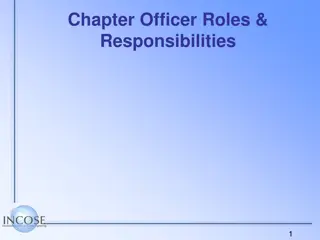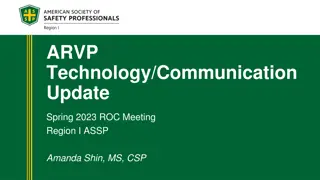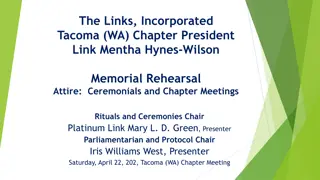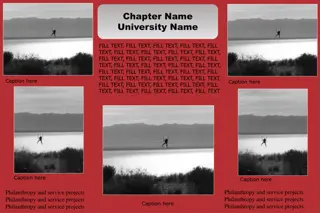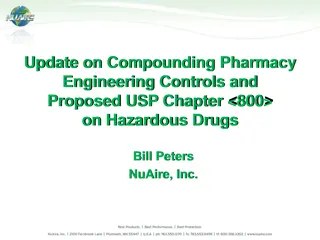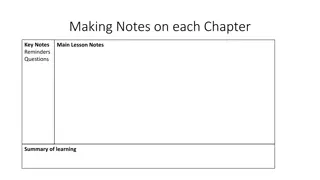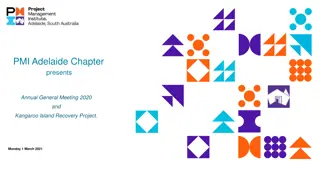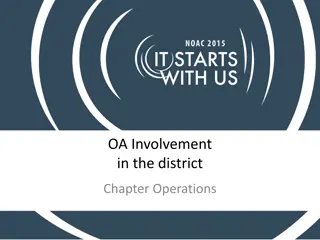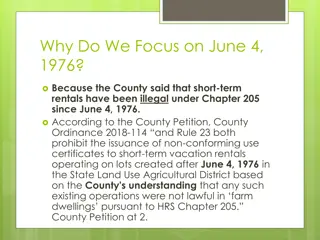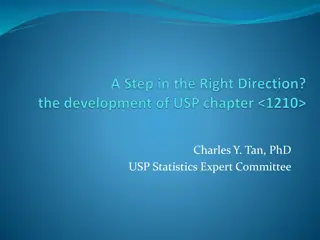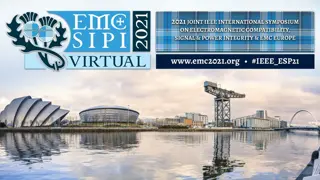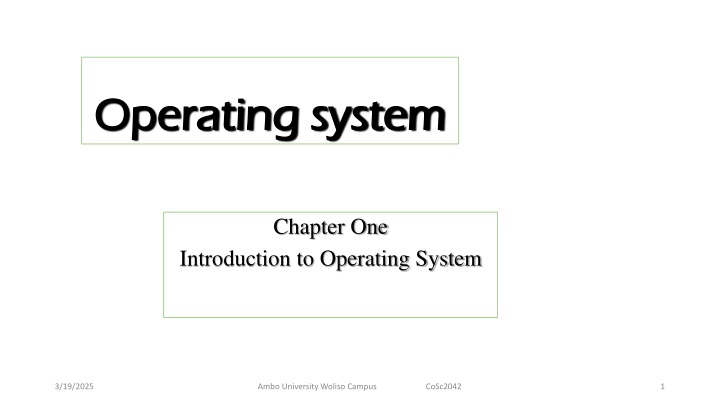
Operating Systems
Explore the evolution of operating systems from the 1950s to the present day, witnessing the advancements in technologies and techniques that have shaped modern computing. Discover the goals, functions, and types of operating systems, reflecting on how they have made user interactions with computers more efficient and convenient. Learn about key milestones in operating system history, including the emergence of multiprogramming, timeshare systems, real-time processing, and multiprocessor architectures.
Download Presentation

Please find below an Image/Link to download the presentation.
The content on the website is provided AS IS for your information and personal use only. It may not be sold, licensed, or shared on other websites without obtaining consent from the author. If you encounter any issues during the download, it is possible that the publisher has removed the file from their server.
You are allowed to download the files provided on this website for personal or commercial use, subject to the condition that they are used lawfully. All files are the property of their respective owners.
The content on the website is provided AS IS for your information and personal use only. It may not be sold, licensed, or shared on other websites without obtaining consent from the author.
E N D
Presentation Transcript
Operating system Operating system Chapter One Introduction to Operating System 3/19/2025 Ambo University Woliso Campus CoSc2042 1
Chapters Contents What is operating system? History of operating system Computer system organization Operating system operation Operating system services Type of an operating system 3/19/2025 Ambo University Woliso Campus CoSc2042 2
What is operating system What is operating system that acts as an intermediary between a user of a computer and the computer hardware. Operating system goals: Execute user programs and make solving user problems easier. Make the computer system convenient to use. Use the computer hardware in an efficient manner. Operating System Functions: Resource allocator - manages and allocates resources. Control program - controls the execution of user programs and operation of I/O devices. Kernel - the one program running at all times (all else being application programs). 3/19/2025 Ambo University Woliso Campus CoSc2042 3
History of operating system In the 1950s some technologies emerged that allowed a simpler interaction between the user and the computer. Resident monitor: - this is a system that loads the program into the computer, reading it from a tape or punched cards. This technology gave rise to the first operating system in history, created in 1956 for an IBM 704 computer, which was responsible for loading programs successively (starting with the next one when the previous one had finished loading), reducing the work time required. Temporary storage: this is a system that also tried to increase speed by simultaneously loading programs and executing tasks. In the 1960s, the rise of the integrated circuit launched the power of computers, and operating systems responded by becoming increasingly complex and offering new techniques. Multiprogramming: - In this technique, the main memory already holds more than one program, and the operating system is responsible for allocating the machine s resources to execute tasks based on existing needs. 3/19/2025 Ambo University Woliso Campus CoSc2042 4
Timeshare: - This is a system that assigns the execution of applications within a group of users working online. Real time: - it is used specially in the area of telecommunications, it is responsible for processing events external to the computer, so that, once a certain time has passed without success, it considers them as failed. Multiprocessor: - these are systems that try to manage the readings and writings made in memory by two programs that are running simultaneously, in order to avoid errors. As their name suggests, they are designed for use in computers that use more than one processor. In the 1970s, IT continued to become increasingly complex, resulting in the first versions of some of the operating systems that have served as the basis for many of the ones we use today, such as UNIX. The operating systems of this decade are still available only to highly qualified users, and their complexity means that they consume a large amount of resources. Among the most outstanding, in addition to UNIX, we find MULTICS, BDOS and CP/M, widely used in computers with Intel microprocessor. 3/19/2025 Ambo University Woliso Campus CoSc2042 5
The 1980s gave rise to the boom in commercial computing. The arrival of computers in thousands of offices and homes changes the focus of operating systems, forcing the development of more user-friendly systems that introduced graphic elements such as menus. In this decade the development is such that it gives rise to some operating systems already legendary, and that contribute to the rise of computing in later decades, such as C++, SunOS (developed by Sun Microsystems and derived from UNIX), AmigaOS (developed for the Commodore Amiga) and some classics such as these:- MS-DOS: - developed by Microsoft for IBM PCs, which contributed enormously to the popularization of computing and gave rise to Windows systems. Mac OS: - a system of Macintosh computers developed by Apple Inc, launched in 1984, and which included a novel graphic interface and the use of the mouse (a rarity at that time for users that were used to typing commands). The decade of the 90 s continues with the explosive line marked in the 80 s, giving rise to many of the operating systems that, in more modern versions, we use today: 3/19/2025 Ambo University Woliso Campus CoSc2042 6
GNU/Linux: it was developed based on UNIX, and which is one of the greatest exponents of free software. Today, GNU/Linux is widely used all over the world, having a pre-eminence close to 100% in fields as striking as supercomputers. Solaris: - also developed on UNIX basis by Sun Microsystems for servers and workstations. Microsoft Windows: - which has resulted in a popular family of commercially successful operating systems used by millions of users around the world. In the first decade of the present century, new operating systems continue to succeed each other, perhaps with less impact than those that emerged in the previous decade, but have their own place. Highlights include SymbOS, MorphOS, Darwin, Mac OS, Haiku and OpenSolaris. So now we see the current decade, in which the rise of phones gives rise to some popular operating systems, including Android, developed by Google or iOS, created by Apple. 3/19/2025 Ambo University Woliso Campus CoSc2042 7
Computer system organization Computer system organization Computer system can be divided into four components Hardware provides basic computing resources CPU, memory, I/O devices Operating system Controls and coordinates use of hardware among various applications and users Application programs define the ways in which the system resources are used to solve the computing problems of the users Word processors, compilers, web browsers, database systems, video games Users People, machines, other computers 3/19/2025 Ambo University Woliso Campus CoSc2042 8
Computer system operation Computer-system operation One or more CPUs, device controllers connect through common bus providing access to shared memory Concurrent execution of CPUs and devices competing for memory cycles 3/19/2025 Ambo University Woliso Campus CoSc2042 9
Computer system operation( Computer system operation(con t o I/O devices and the CPU can execute concurrently. oEach device controller is in charge of a particular device type. oEach device controller has a local buffer. oCPU moves data from/to main memory to/from local buffers oI/O is from the device to local buffer of controller. Device controller informs CPU that it has finished its operation by causing an interrupt. Interrupt transfers control to the interrupt service routine generally, through the interrupt vector, which contains the addresses of all the service routines. Interrupt architecture must save the address of the interrupted instruction. Incoming interrupts are disabled while another interrupt is being processed to prevent a lost interrupt. A trap is a software-generated interrupt caused either by an error or a user request. An operating system is interrupt driven. Ambo University Woliso Campus CoSc2042 con t ) ) 3/19/2025 10
Storage structure oMain memory only large storage media that the CPU can access directly. oSecondary storage extension of main memory that provides large nonvolatile storage capacity. oMagnetic disks rigid metal or glass platters covered with magnetic recording material Disk surface is logically divided into tracks, which are subdivided into sectors. The disk controller determines the logical interaction between the device and the computer. oCaching copying information into faster storage system; main memory can be viewed as a last cache for secondary storage. oStorage systems organized in hierarchy. Speed Cost Volatility 3/19/2025 Ambo University Woliso Campus CoSc2042 11
Storage Storage- -Device Hierarchy Device Hierarchy Less Cost and slow High Cost and fast 3/19/2025 Ambo University Woliso Campus CoSc2042 12
Migration of A From Disk to Register oData transfer between cache to CPU is hardware function without OS intervention. oTransfer from disk to memory is usually controlled by OS. 3/19/2025 Ambo University Woliso Campus CoSc2042 13
I/O structure I/O structure After I/O starts, control returns to user program only upon I/O completion. Wait instruction idles the CPU until the next interrupt Wait loop (contention for memory access). At most one I/O request is outstanding at a time, no simultaneous I/O processing. After I/O starts, control returns to user program without waiting for I/O completion. System call request to the operating system to allow user to wait for I/O completion. Device-status table contains entry for each I/O device indicating its type, address, and state. Operating system indexes into I/O device table to determine device status and to modify table entry to include interrupt. 3/19/2025 Ambo University Woliso Campus CoSc2042 14
Direct Memory Access Structure Direct Memory Access Structure oUsed for high-speed I/O devices able to transmit information at close to memory speeds. oDevice controller transfers blocks of data from buffer storage directly to main memory without CPU intervention. oOnly one interrupt is generated per block, rather than the one interrupt per byte. 3/19/2025 Ambo University Woliso Campus CoSc2042 15
Operating system operation Operating system operation Interrupt driven by hardware Software error or request creates exception or trap Division by zero, request for operating system service Other process problems include infinite loop, processes modifying each other or the operating system Dual-mode operation allows OS to protect itself and other system components User mode: execution done on behalf of a user. Monitor mode (also kernel mode or system mode) : execution done on behalf of operating system. Mode bit added to computer hardware to indicate the current mode: monitor (0) or user (1). Some instructions designated as privileged, only executable in kernel mode System call changes mode to kernel, return from call resets it to user 3/19/2025 Ambo University Woliso Campus CoSc2042 16
Transition from User to Kernel Mode Transition from User to Kernel Mode Timer to prevent infinite loop / process hogging resources Set interrupt after specific period Operating system decrements counter When counter zero generate an interrupt Set up before scheduling process to regain control or terminate program that exceeds allotted time 3/19/2025 Ambo University Woliso Campus CoSc2042 17
Operating system services Operating system services One set of operating system service provides functions that are helpful to user. Program execution - ability to load a program into memory and to run it. I/O operations - since user programs cannot execute I/O operations directly, the operating system must provide some means to perform I/O. File-system manipulation - capability to read, write, create, and delete files. Communications - exchange of information between processes executing either on the same computer or on different systems tied together by a network. Implemented via shared memory or message passing. Error detection - ensure correct computing by detecting errors in the CPU and memory hardware, in I/O devices, or in user programs. 3/19/2025 Ambo University Woliso Campus CoSc2042 18
Operating system service( Operating system service(con t Additional operating-system functions exist not for helping the user, but rather for ensuring efficient system operation. Resource allocation - allocating resources to multiple users or multiple processes running at the same time. con t ) ) Accounting - keep track of and record which users use how much and what kinds of computer resources for account billing or for accumulating usage statistics. Protection - ensuring that all access to system resources is controlled. 3/19/2025 Ambo University Woliso Campus CoSc2042 19
Operating system common component Operating system common component oUser interface oProcess Management oMain Memory Management oSecondary-Storage Management oI/O System Management oFile Management oProtection System Networking 3/19/2025 Ambo University Woliso Campus CoSc2042 20
Process Management Process Management A process is a program in execution. A process needs certain resources, including CPU time, memory, files, and I/O devices, to accomplish its task. The operating system is responsible for the following activities in connection with process management. Process creation and deletion. process suspension and resumption. Provision of mechanisms for: process synchronization process communication 3/19/2025 Ambo University Woliso Campus CoSc2042 21
Main Main- -Memory Management Memory Management oMemory is a large array of words or bytes, each with its own address. It is a repository of quickly accessible data shared by the CPU and I/O devices. oThe operating system is responsible for the following activities in connection with memory management: Keep track of which parts of memory are currently being used and by whom. Decide which processes to load when memory space becomes available. Allocate and deallocate memory space as needed. e.g. the C function 'malloc' (or 'New' in Pascal) allocates a specified amount of memory; this happens via an OS call. The functions 'free'(C) and 'Dispose'(Pascal) deallocate this memory. 3/19/2025 Ambo University Woliso Campus CoSc2042 22
Secondary Secondary- -Storage Management Storage Management Since main memory (primary storage) is volatile and too small to accommodate all data and programs permanently, the computer system must provide secondary storage to back up main memory. Most modern computer systems use disks as the principle on-line storage medium, for both programs and data. The operating system is responsible for the following activities in connection with disk management: Free space management Storage allocation Disk scheduling 3/19/2025 Ambo University Woliso Campus CoSc2042 23
I/O System Management I/O System Management The I/O system consists of: o A buffer-caching system o A general device-driver interface o Drivers for specific hardware devices 3/19/2025 Ambo University Woliso Campus CoSc2042 24
File Management File Management A file is a collection of related information defined by its creator. Commonly, files represent programs (both source and object forms) and data. The operating system is responsible for the following activities in connections with file management: File creation and deletion. Directory creation and deletion. Support of primitives for manipulating files and directories. Mapping files onto secondary storage. File backup on stable (nonvolatile) storage media. 3/19/2025 Ambo University Woliso Campus CoSc2042 25
Protection System Protection System Protection refers to a mechanism for controlling access by programs, processes, or users to both system and user resources. The protection mechanism must: distinguish between authorized and unauthorized usage. specify the controls to be imposed. provide a means of enforcement. 3/19/2025 Ambo University Woliso Campus CoSc2042 26
Any Queries 3/19/2025 Ambo University Woliso Campus CoSc2042 27

